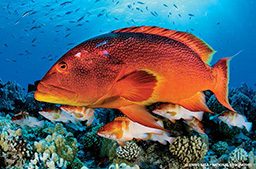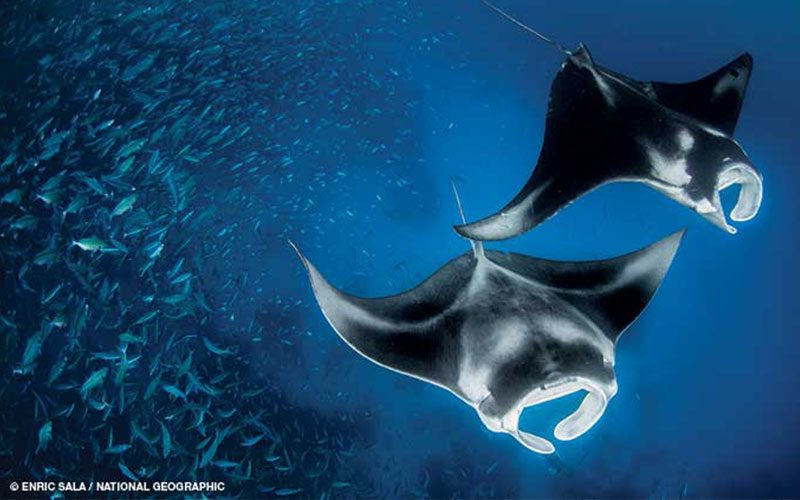While many people are scared of sharks, some sharks are scared of bubbles. “Cocos Island is one of the sharkiest places on earth,” says marine ecologist and National Geographic Explorer-in-Residence Enric Sala. “There’s a seamount half a mile off the island. A hundred feet down we’d go to the edge and wait, and soon 200 hammerhead sharks would come over us. I have one picture I took where I counted 122 sharks just in one frame, but when we’d exhale they’d take off and go in all directions. They don’t like the bubble sounds.”

With more than 4,000 dives under his weight belt, the tall, slim and affable, 46-year-old scientist raised near Catalonia’s Costa Brava doesn’t seem like your typical swashbuckler. But as founder and head of National Geographic Society’s Pristine Seas project, he’s dived, documented and helped protect some of the most remote and beautiful underwater habitats on our blue planet.
Brought up on good food from his family’s restaurant and Jacques Cousteau specials on TV, Sala studied biology at the University of Barcelona before receiving his doctorate in ecology from the University of Aix-Marseille II in 1996. To get his doctorate he compared marine life inside and outside a small no-take marine reserve on the Costa Brava, diving 250 days in the first year of his research. He went on to study local kelp forests at the Scripps Institution of Oceanography in La Jolla, Calif., and he later researched the ecology of reefs and the impact of fishing in the Gulf of California (Sea of Cortez).
In 2001 Sala helped design a network of marine reserves for Baja and later documented a more than 400 percent increase in biomass (total weight of marine life) during a 10-year period within Cabo Pulmo’s marine reserve (see Alert Diver, Winter 2014). He also did research dives in Cuba, Belize and Brazil but came to feel that the science he was doing wasn’t accomplishing enough. “One day I realized I was writing the obituary of ocean life. It felt like I was telling a patient in excruciating detail how she would die, and that’s not what I wanted,” Sala says.

Wanting to do something proactive for the oceans he loved, Sala led a 2005 expedition to Palmyra Atoll and the uninhabited Kingman Reef some 1,000 miles south of Hawaii. That expedition changed science’s understanding of how life works on coral reefs. “We discovered the ‘inverted pyramid,'” Sala explains, “where most of the biomass is actually predators. You jump in the water, and as soon as your bubbles clear you’re surrounded by sharks. If you weigh all the fish on the reef, the top predators outweigh the prey.
“On land, you see these vast herds of wildebeest and a few predators, so you think that’s how it is in the ocean,” he continues. “That’s also how we experience it on reefs that have seen lots of human impacts. But the truth is, on a healthy reef there’s more than one lion per wildebeest. There are sharks, trevally, very big snappers, but mostly the biomass is sharks. And it takes many damselfish to equal the weight of a single shark.”
Sala realized that our understanding of marine ecosystems was distorted by the lack of unexplored and unexploited ocean habitats to provide good models for how the ocean works in a natural state. He decided he needed to go to the most remote parts of the ocean and protect them. He quit Scripps and in 2008 convinced National Geographic to launch the Pristine Seas project to explore, survey and protect these last wild places.

Since then, Sala has led 10 of the 12 Pristine Seas expeditions, each lasting three to six weeks and involving 10 to 40 explorers, including both scientists and media. The United States, Costa Rica, Gabon, Chile and Kiribati have now protected five of the 12 Pristine Seas sites — some 150,000 square miles of ocean. In March 2015 Great Britain announced it will protect 322,000 square miles around the Pitcairn Islands (where the HMS Bounty‘s mutineers settled), making it the largest continguous marine protected area in the world.
Asked about the most challenging expedition to date, Sala immediately recalls Pristine Seas’ 2013 visit to Russia’s Franz Josef Land in the Arctic Ocean, where they dived in 30°F waters after a three-day sail north from Murmansk. “In the 1970s this was mostly ice covered in the summer, but now it’s open water with lots of icebergs,” Sala says. “We were wearing drysuits with 10mm hoods and three-finger 7mm mitts. But after about 30 minutes diving, your hands are numb, and at 45 minutes you can’t feel your hands or lips. And when you’d get out, they’d have to unzip you and pull the camera from your hands because you couldn’t feel or do anything. We had a cooler of hot water on our zodiac, and you’d put your hands into it; it was very painful, but at least you could feel them then.
“There were polar bears and walruses and seabirds, and we’d see all these life forms underwater, including big sea spiders and incredible kelp forests,” he continues. “If the water were warm, this would be one of the most beautiful (and visited) places in the world. And while there are few fish to be seen, there are all these massive clam-eating walruses. The babies are curious and come right up to you until the adults — the dads or moms — herd them away. To do so, they pop up right next to you, and that — a one-ton animal right next to you — can be kind of scary.

“On the same trip we had an iceberg capsize. I was in the zodiac yelling at a group of seven divers on the surface near the iceberg to swim for the boat. They didn’t know if there was a polar bear swimming behind them or what, but they swam as hard as they could. Just as they got to us I saw the iceberg starting to turn, and then this berg, about the size of a small house, just completely overturned.”
Sala recalled another challenging expedition when he and his crew dived at the Sala y Gómez volcanic islands near Chile’s Easter Island. They were near big breakers from the Southern (Antarctic) Ocean that were crashing over the emerging islets. “It was like diving in a washing machine,” he says. “For the first 10 minutes, you’d get pushed up and down for 5 meters (16 feet) at a time, and the dive computers just went crazy beeping at us. It made for some good video, but it was tough to adjust to.”
It was worth the difficulty: There they swam with big, majestic Galapagos sharks, huge jacks and spiny lobsters the size of bulldogs, one-third larger than the largest ever before reported.
In yet another distressing if somewhat amusing situation, while swimming with his buddy and chief scientist Alan Friedlander in the Line Islands (south of Hawaii in the central Pacific Ocean), Sala felt his ponytail being tugged. He turned around, but instead of seeing Friedlander, Sala discovered a two-foot red snapper pulling his hair with its vampirelike teeth. Later he got bit on the ear by another snapper, as did photographer Brian Skerry. “I’m not afraid of sharks, but those fish are just too curious,” he complains.
Asked about his favorite site, Sala names Millennium Atoll (Caroline Island), also in the southern Line Islands, where 90 percent of the sea bottom is covered in live coral and swarming with big fish. “The little fish are all paranoid,” he jokes, “hiding in the crevices.” He says if aliens came to earth and asked to see a coral reef, that’s where he’d take them.

He is proud of the astounding science, adventure and marine wilderness protection that have grown out of the Pristine Seas project, but he’s equally proud of his expeditions’ safety record. “We do our explorations with scuba and nitrox, but more recently we’ve gone to rebreathers and can do four to six hours a day of diving, so we’re very aware of our situation,” Sala says. “With our core team, we’ve done thousands of dives together, but we still have our DAN oxygen kits on every boat, we’re trained for CPR, and on every trip we review all the basics of dive safety.
“At Malden Island in the Line Islands we were five days from Tahiti and the nearest hospital, and there are no airstrips on these islands, so an air evacuation is not an option. That’s why each diver is outfitted like a Christmas tree: We have the safety sausage and whistle attached to the BC and a signal mirror, flashlight and beacon locator with a VHF radio signal and GPS locator on it.
“We have a diving safety officer and two hyperbaric chambers — a two-person metal one on deck and an inflatable one — and most of our diving is done well clear of the safety limits. We don’t want to do decompression,” he continues. “There were a couple of infections after scrapes from metal on the older boats, and we had one broken toe from a weight belt but no close calls — except for the iceberg.”
Last September former President Bill Clinton announced the National Geographic Society’s plans to expand the Pristine Seas project to convince world leaders to protect an additional 770,000 square miles of ocean. With awareness of the importance of marine protected areas growing around the world, Sala and his colleagues may have to defer or even cancel the ocean’s obituary.
© Alert Diver — Q2 Spring 2015